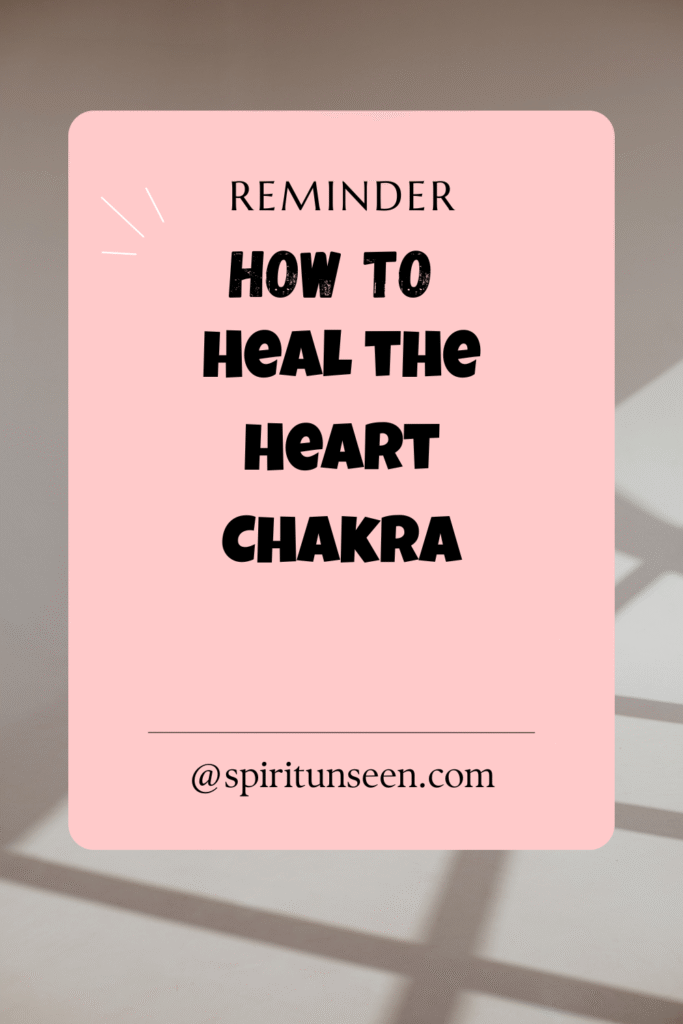
Healing the Heart Chakra
Throughout the previous year during collective reiki gatherings, I’ve discovered that our community requires profound heart chakra restoration. There exists trauma within this energetic center.
I’ve been spiritually directed to investigate this subject more thoroughly because it’s evident that humanity yearns for love. Love serves as the channel through which we can expand our awareness, view ourselves with fresh perspective and connect deeply with others.
The heart represents the fourth chakra within the energetic body. It correlates with love, closeness, social identity and connections. Though the wellness of other chakras remains certainly significant, the strength of the heart holds supreme importance because love represents the most potent healing force.
When the heart center thrives, we demonstrate characteristics including: compassion, empathy, love, selflessness and equilibrium. We also maintain self-love and robust immune function.
When it’s diminished, there’s a pattern toward bitterness, reluctance to forgive, isolation, narcissism, depression, antisocial tendencies, criticism and intimacy fears. We exclude others to prevent experiencing hurt again.
When it’s excessive, there’s a leaning toward: jealousy, treating love addictively, overwhelming others, attachment, codependency, validation seeking, possessiveness and weak boundaries. We overwhelm others with affection from fear they’ll leave us or because we subconsciously utilize them as substitutes for our own unmet needs.
It’s completely normal to oscillate between these polarities and display characteristics from both categories during your healing journey.
Heart chakra dysfunction can also appear physically. Related symptoms might include: cardiac issues, circulation problems, asthma, shoulder stress, immune weakness, chest discomfort plus lung, breast and arm difficulties.

Complete Eclipse of the Heart
Anodea Judith, writer of Eastern Body Western Mind, considers that the world’s heart chakra dysfunction stems largely from losing the Mother archetype. Many children in today’s generation matured in fractured families and this familial division has expressed itself in the separations observable in society broadly. Our community is split as demonstrated by increased polarization in political parties, race, gender, class, etc. She even suggests that we’ve “lost love for the world” and this has caused behavioral shifts including isolation, defensiveness, alienation and selfishness. We’ve forgotten relating to each other because we’re disconnected from our own hearts. This is regrettable because how we connect with others is through the skill of relating.
Love is the great expander. It broadens our awareness and creates the bridge between body, mind and soul. It’s the crossroads between the mystical and the ordinary. Love enables us to access the divine or source energy within us. It’s also the greatest mirror of all, a direct gateway to the shadow. Within us all we possess divine feminine and divine masculine energy. Jung called this the anima and the animus. When the heart chakra is vibrant and healthy these two forces are balanced. The reality is that most of us still have some work to do and therefore our unconscious shadow materials often play out on the stage of our relationships.

The Shadow in Relationships
Frequently when we initially enter relationships we perceive the other person through rose-colored glasses. There’s an idealization that happens, where we view them as nearly perfect. What we’re actually doing is projecting our own inner divinity onto our partner. If we don’t make an effort to see them for who they really are instead of being blinded by our own projection, the relationship will suffer and may not even last. According to Robert A. Johnson, love based on reality rather than divinity while less exciting, is far more stable and fulfilling in the long run.
Another example of shadow manifesting in relationships is a woman who is a type-A workaholic and puts her career first. She may have unconsciously chosen a partner to carry her feminine (anima) because her masculine (animus) is over-expressed. When she approaches her mid-life crisis she may find that what she initially found attractive in her husband — his sensitive (feminine) nature — is now a quality she holds in contempt. This is a strong indication that the anima or animus has been projected onto the partner.

Achieving Balance
We participate in shadow work by examining our behaviors, motivations, dreams and fears in a self-reflective manner, free of judgment. The objective is to contemplate these aspects of ourselves, discover the connections between them and attempt to unite them to achieve wholeness. Essentially, balancing our inner masculine and feminine energies. There’s also a balance to be achieved between honoring our soul’s desire for attachment with our spirit’s desire for freedom.
I believe that love is the most powerful healer of all. Consequently, any impairment in our capacity to give and receive love is an acute wound indeed. If you think about how this is magnified by all the people with similar wounds operating in the world and how we treat one another it is a serious issue. This is why heart chakra healing is so important. Having compassion for others is one way to mend this suffering. What many do not realize is that 90% of the time, compassion doesn’t translate to offering a solution to someone’s problems or fixing things for them. Compassion means being understanding and contributing empathy. Sometimes relationships run into trouble when one person wants a listening ear, but the other thinks they are expected to fix the problem. At the end of the day we want someone to empathize with what we are going through. We are all connected.

How Childhood Influences the Heart Chakra
Another domain that impacts the heart chakra is our social identity. When we are children our parents or caregivers play a large part in shaping behavior. The behaviors that children see at home are internalized and then replicated within their own relationships. For example, if Johnny saw Dad push Mom around then he may embody the Bully archetype and push around his vulnerable classmates. Another way social conditioning can occur is when a child benefits from a certain behavior. For example, Mom largely ignores Johnny except when he breaks the rules. Johnny likes the attention that he receives from Mom when he breaks the rules so he adopts the Rebel archetype which may become an enduring role.
Behaviors are not the only things we absorb from our caregivers as children, we often internalize their values and attitudes towards us too. Our relationship with our Mother for example colors the way we see the Divine Feminine and our idea of the Mother archetype. If the relationship with our Mother was not a positive and loving one there is a tendency to project this impairment onto our other relationships. The number one reason most people withhold love and close their hearts is due to fear of rejection. As children, to be rejected is a kind of death. If we still identify with the caregiver who rejected us then we will mirror their behavior and reject ourselves. Again, the antidote to this is to identify the various parts of ourselves and integrate them to become whole. In doing so we are able to open our hearts to relating to others.
How to Restore the Heart Chakra
1. Inner Family Exercise
Create a list of the different aspects of yourself or your personality. You can also consider them as your personal archetypes. Some examples include Lover, Achiever, Wounded Child, Inner Critic, Mother, etc. Write down words that describe them as well as what they ultimately want. Then tease out any relationships you can identify between these various inner characters. By acknowledging and integrating the many aspects of ourselves our self-knowledge grows and we are able to move towards greater wholeness.
Example:
The Achiever — determined, ambitious, driven; wants to succeed, make a mark on the world, gain recognition and earn lots of money.
Relationships: My Inner Critic suppresses the progress of the Achiever and diminishes her energy. I can call on the Coach or Mother archetype to thwart the upper limiting attempts of my Inner Critic.
2. Open the Heart to Feeling
According to Anodea Judith, “feelings are the antennae of the soul.” If you don’t allow yourself to open up to your feelings you will cut off vital life force energy to the heart. By allowing emotions to flow naturally we can finally release less-than-pleasant feeling states such as anger and grief. Next time you have the urge to avoid an emotion, choose to accept it instead and let it in like an invited guest. Allow it to stay for as long as it needs. While this may sound counterintuitive, it is remarkably therapeutic in today’s day and age where we often use tv, social media, work and other general busy-ness to distract and numb ourselves from feeling.
3. Breathing Techniques
Breathwork serves as a gateway to the heart, a channel through which we can access stored feelings in the energy body. Make the conscious decision to become more aware of the way you breathe on an everyday basis. Perhaps certain activities like painting or shamanic journeying cause your normal breathing pattern to become temporarily altered. Or maybe you notice that you hold your breath when your mind dwells on certain thoughts or during certain yoga poses. Many people breathe in a very shallow manner without even realizing it. Allow your breathing to become deep, steady and expansive; you may discover that your qi, or life force energy, expands in kind. If any dormant feelings arise, acknowledge them and be gentle with yourself. You may also want to explore different types of breathwork if you feel so called such as pranayama, ujjayi or my favorite, heart-womb breathing.
4. Grief Counseling
If your heart chakra is carrying grief, you may consider seeking the support of a therapist for some deeper healing. Take time to examine what role the person you lost played in your life and how you can fill in that missing part on your own or regain it.
5. Forgiveness
Forgiveness is the ultimate gesture of healing. It is a form of heart cleansing that allows us to open more fully to receiving love. In Kathrin Zenkina’s book, Unleash Your Inner Money Babe, she asks readers to participate in a forgiveness exercise. The directive is to write down at least 50 ways you have been wronged by others (and yourself). Next, you go down the list and recite the Hawaiian prayer of Ho’oponopono for each entry:
“I love you, thank you, I forgive you, I’m sorry.”
Doing this with a sincere heart and a willingness to forgive is wildly cathartic. And in the future, when someone wrongs you, even if it’s Joe Schmo who cuts you off in traffic, immediately recite the prayer. In doing so you are clearing your aura of blame and other toxic energy that brings you pain. As a result your heart will become open to the flow of love and abundance once more, the gifts that are your birthright.
6. EFT Tapping
EFT Tapping is a technique in which you use your hands to tap on various energy points or pathways in the body in order to release stored emotions. When we experience trauma or negatively-charged memories, the painful emotions that accompany them are often held in the body. Modern science is just beginning to acknowledge the mind-body connection. Many times illnesses or other physical ailments are merely symptoms of underlying emotional anguish. Tapping is a therapeutic method that addresses the need for both physical and emotional purification, recognizing that they are equally important for a person’s health and well-being.
How to engage in EFT:
Start by focusing on a troublesome thought, memory, problem or emotion that distresses you and allow yourself to feel it in your body. Then use your fingers to tap 5 times on each of the body’s meridians while reciting an affirmation:
“Even though I _______ (example: have anxiety, am self-conscious about my stomach, feel angry, dislike my job, etc.), I completely love and accept myself.
